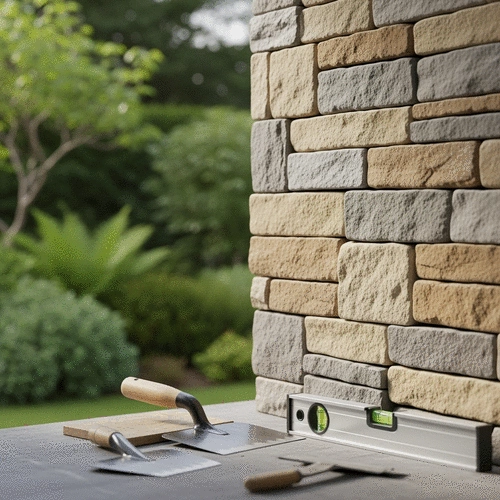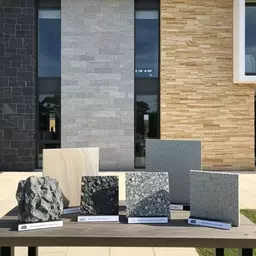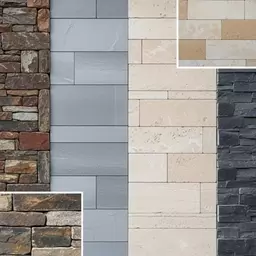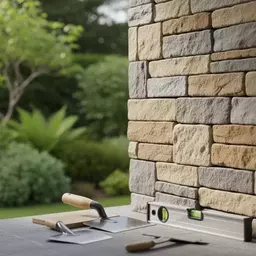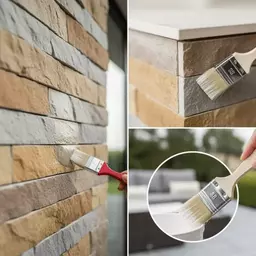In today's world, the architecture of our buildings must not only captivate our senses but also care for our planet. As you explore sustainable stone cladding, consider how your choices can impact both aesthetics and the environment.
What You Will Learn
- Sustainable stone cladding combines durability and aesthetic appeal while minimizing environmental impact.
- Ethical sourcing and low-impact installation techniques are critical for reducing the ecological footprint of construction.
- Traditional stone cladding contributes to resource depletion, high carbon emissions, and significant waste generation.
- Choosing natural stones like limestone, marble, and sandstone can enhance sustainability through their unique benefits.
- Integrating recycled materials and low-VOC finishes is essential for promoting eco-friendly cladding designs.
- Local sourcing not only reduces transportation emissions but also supports local economies and enhances material suitability for local climates.
The Pillars of Sustainable Stone Cladding
Understanding the core components of sustainable stone cladding, from material sourcing to production methods, is essential for eco-conscious construction.
Defining Sustainable Stone Cladding
- Ethical Sourcing: Minimal environmental disruption.
- Low-Impact Installation: Reduces waste & energy.
- Long-lasting Durability: Limits replacements.
Environmental Impact of Traditional Cladding
- Resource Depletion: Scarcity, ecological imbalance.
- High Carbon Emissions: Energy-intensive processes.
- Waste Generation: Landfill burden.
Role of Sustainable Architecture
- Innovative Designs: Efficient stone use.
- Holistic Approach: Considers environmental impact.
- Community Engagement: Reflects local needs.
Key Eco-Friendly Stone Types & Benefits
- Limestone: Durable, carbon-neutral, minimal processing.
- Marble: Sustainably sourced, timeless beauty.
- Sandstone: Abundant, local sourcing reduces emissions.
Benefits: Longevity, Low Maintenance, Natural Aesthetic.
Innovative Sustainable Practices
Recycled Materials:
- Glass Reinforced Concrete.
- Reclaimed Stone (cost-effective).
Low-VOC Finishes: Essential for healthy air quality.
Energy-Efficient Production: Renewable energy, efficient water use.
The Importance of Local Sourcing
- Reduces transportation emissions.
- Supports local economies & craftsmen.
- Ensures materials suit local climate (durability).
Understanding Sustainable Stone Cladding and Its Importance
At Aurora Stone Cladding, we believe that sustainability is not just a trend—it's an essential component of modern architecture. As we navigate the shifting landscape of construction, understanding sustainable stone cladding becomes crucial. But what exactly does it mean? Sustainable stone cladding refers to the use of environmentally friendly materials and practices in the installation and maintenance of stone façades. It combines durability with aesthetic appeal while minimizing negative impacts on the environment.

By focusing on sustainable options, we can create beautiful spaces that are not only visually stunning but also responsible in their resource use. As a passionate advocate for innovative architectural design, I'm excited to share insights into why sustainable stone cladding matters now more than ever!
Defining Sustainable Stone Cladding in Modern Construction
The term "sustainable stone cladding" encompasses various practices aimed at reducing the ecological footprint of building materials. This includes sourcing stones that are quarried ethically and using construction methods that limit waste. Additionally, it involves considering the life cycle of materials, ensuring they are built to last while keeping maintenance needs minimal. For more detailed information on selecting environmentally friendly options, explore our guide on sourcing sustainable stone cladding materials.
- Ethical sourcing: Choosing materials that are extracted with minimal environmental disruption.
- Low-impact installation: Utilizing techniques that reduce waste and energy consumption.
- Long-lasting durability: Selecting stones that endure weathering and wear over time, limiting the need for replacements.
By adopting these principles, we can effectively enhance both the function and beauty of our structures while promoting environmental stewardship.
The Environmental Impact of Traditional Stone Cladding
Traditional stone cladding methods often contribute to significant environmental challenges. From excessive quarrying that disrupts ecosystems to high-energy processing techniques, the impact can be quite detrimental. It's essential to recognize that these practices not only harm our planet but can also affect the longevity and aesthetics of our buildings.
- Resource depletion: Over-extraction of natural resources can lead to scarcity and ecological imbalance.
- High carbon emissions: The energy-intensive processes involved in stone production can contribute to global warming.
- Waste generation: Inefficient installation practices can result in considerable waste that burdens landfills.
By understanding these impacts, we can make informed choices that prioritize sustainability in our projects.
Exploring the Role of Sustainable Architecture in Stone Cladding
Sustainable architecture plays a pivotal role in the evolution of stone cladding. It encourages the integration of eco-friendly practices throughout the design and construction processes. Architects and builders are increasingly collaborating to select materials that not only enhance visual appeal but also align with sustainability goals.
- Innovative designs: Sustainable architecture promotes creative solutions that utilize stone cladding efficiently.
- Holistic approach: This perspective considers the environmental impact of each design decision, from materials to energy use.
- Community engagement: Sustainable projects often involve local communities, ensuring that their needs and values are reflected in the design.
As we move forward, the fusion of sustainable architecture with stone cladding will continue to redefine how we build, making our environments not only attractive but also resilient and responsible.
We Want to Hear From You!
As you consider sustainable stone cladding options for your next project, what factors are most important to you? Is it the aesthetic appeal, the environmental impact, or perhaps the longevity of the materials? Share your thoughts below:
Choosing Eco-Friendly Materials for Sustainable Stone Cladding
When embarking on your journey towards sustainable stone cladding, the choice of materials plays a critical role. At Aurora Stone Cladding, I often emphasize the significance of selecting eco-friendly options that not only enhance the beauty of your space but also contribute positively to our environment. Understanding the different types of stone and their sustainability can empower you to make informed decisions like choosing between natural vs. engineered stone cladding.
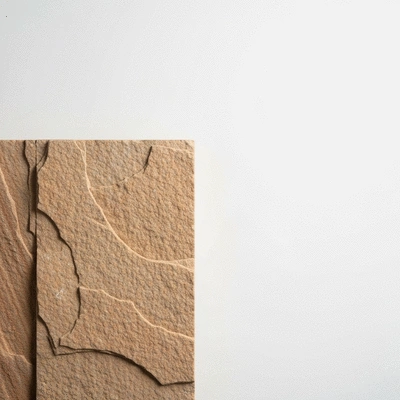
Let’s dive into some popular natural stone options and their unique benefits for sustainability. Knowing these will help you align your design aesthetic with your values.
Natural Stone Types: Exploring Limestone, Marble, and Sandstone
Each type of natural stone offers unique characteristics and advantages when it comes to sustainability:
- Limestone: Known for its durability and energy efficiency, limestone is a carbon-neutral material that requires minimal processing.
- Marble: While traditionally viewed as a luxury option, high-quality marble can be sustainably sourced, offering timeless beauty and lasting performance.
- Sandstone: This versatile stone is abundant and can be sourced locally, reducing transportation emissions and supporting local economies.
By selecting any of these stones, you not only enhance your space but also consider the environmental footprint of your choices.
Benefits of Each Stone Type on Sustainability
Choosing the right stone type can significantly impact your project's sustainability profile. Let’s take a look at some benefits:
- Longevity: These stones are known for their durability, meaning they won’t need frequent replacements.
- Low Maintenance: Natural stones, particularly limestone and sandstone, often require less intensive care, which can lead to lower resource usage over time.
- Natural Aesthetic: The organic look of these stones compliments various architectural styles while promoting a connection to nature.
Embracing these natural stone options aligns perfectly with my passion at Aurora Stone Cladding, as we focus on creating elegant spaces that last.
Recycled Materials and Their Role in Eco-Friendly Cladding
As we move towards greater sustainability, integrating recycled materials into your cladding projects can make a remarkable difference. Using recycled stone not only reduces waste but also conserves natural resources by minimizing the need for new quarrying.
- Glass Reinforced Concrete: This innovative material combines recycled glass with concrete to create beautiful, strong finishes.
- Reclaimed Stone: Sourcing reclaimed stone from older buildings not only preserves history but also lessens the demand for new materials.
Utilizing recycled materials can be a game-changer in creating sustainable designs that maintain aesthetic appeal without sacrificing environmental integrity.
Understanding Low-VOC Finishes and Their Importance
Another component to consider is the use of low-VOC (volatile organic compounds) finishes. These finishes are crucial for ensuring that your space remains healthy and free from harmful emissions. By opting for low-VOC options, you’re not only enhancing the interior air quality but also supporting a sustainable building practice.
At Aurora Stone Cladding, we prioritize these eco-friendly options in our project consultations to ensure that your home not only looks stunning but also promotes a healthier living environment.
Energy-Efficient Production Methods for Stone Materials
The production process of stone materials can significantly impact their overall sustainability. Choosing suppliers that utilize energy-efficient methods can make a notable difference.
- Renewable Energy: Look for manufacturers who power their operations with renewable energy sources, reducing carbon footprints.
- Efficient Water Use: Companies that implement water-saving measures during production contribute to better overall resource management.
Being conscious about production methods can enhance your project’s sustainability credentials while also ensuring you’re supporting responsible businesses.
The Importance of Local Sourcing for Sustainable Stone Cladding
One of the best ways to ensure sustainability in your stone cladding project is through local sourcing. By choosing materials sourced locally, you can:
- Reduce transportation emissions, leading to a lower carbon footprint.
- Support local economies and craftsmen, fostering community growth.
- Ensure the materials are well-suited to your local climate, enhancing durability and performance.
At Aurora Stone Cladding, we champion local sourcing as part of our commitment to sustainability and community support.
Cost-Effective Solutions with Reclaimed Materials
Utilizing reclaimed materials not only offers an eco-friendly alternative but can also be a cost-effective solution for your projects. These materials often come at a lower price point due to their availability and provide unique character to any design. Reclaimed stone can be a stunning choice, and for more insights into sustainable options, read about sustainable stone cladding sourcing tips.
Reclaimed stone can serve as a stunning centerpiece for your home while contributing to a sustainable lifestyle—something I truly advocate for in my work.
FAQs About Sustainable Stone Cladding
What is sustainable stone cladding?
Sustainable stone cladding involves using environmentally friendly materials and practices for stone façades. This includes ethical sourcing, low-impact installation, and selecting durable stones to minimize environmental impact and ensure longevity.
Why is sustainable stone cladding important?
It's crucial for modern architecture to minimize environmental impact. By choosing sustainable options, we reduce resource depletion, lower carbon emissions, decrease waste generation, and promote healthier living environments, all while maintaining aesthetic appeal.
What are the environmental impacts of traditional stone cladding?
Traditional methods can lead to excessive quarrying that disrupts ecosystems, high energy consumption for processing (contributing to carbon emissions), and significant waste generation that burdens landfills.
Which natural stones are considered eco-friendly for cladding?
Limestone, marble, and sandstone are excellent choices. Limestone is durable and carbon-neutral, marble can be sustainably sourced for timeless beauty, and sandstone is abundant and can be locally sourced to reduce emissions.
How do recycled materials contribute to sustainable cladding?
Integrating recycled materials like glass-reinforced concrete and reclaimed stone reduces waste, conserves natural resources by lessening the need for new quarrying, and can also offer cost-effective solutions.
What are low-VOC finishes, and why are they important?
Low-VOC (volatile organic compounds) finishes are crucial for ensuring healthy indoor air quality by reducing harmful emissions. They support sustainable building practices and promote a healthier living environment.
What is the benefit of local sourcing for stone cladding?
Local sourcing reduces transportation emissions, supports local economies and craftsmen, and ensures that materials are well-suited to the local climate for enhanced durability and performance.
Recap of Key Points
Here is a quick recap of the important points discussed in the article:
- Sustainable stone cladding combines durability and aesthetic appeal while minimizing environmental impact.
- Key practices include ethical sourcing, low-impact installation, and selecting durable materials.
- Traditional stone cladding can lead to resource depletion, high carbon emissions, and waste generation.
- Sustainable architecture promotes innovative designs and community engagement in building practices.
- Choosing eco-friendly materials like limestone, marble, and sandstone enhances sustainability and beauty.
- Utilizing recycled materials and low-VOC finishes contributes to healthier living environments.
- Local sourcing reduces transportation emissions and supports community economies.

